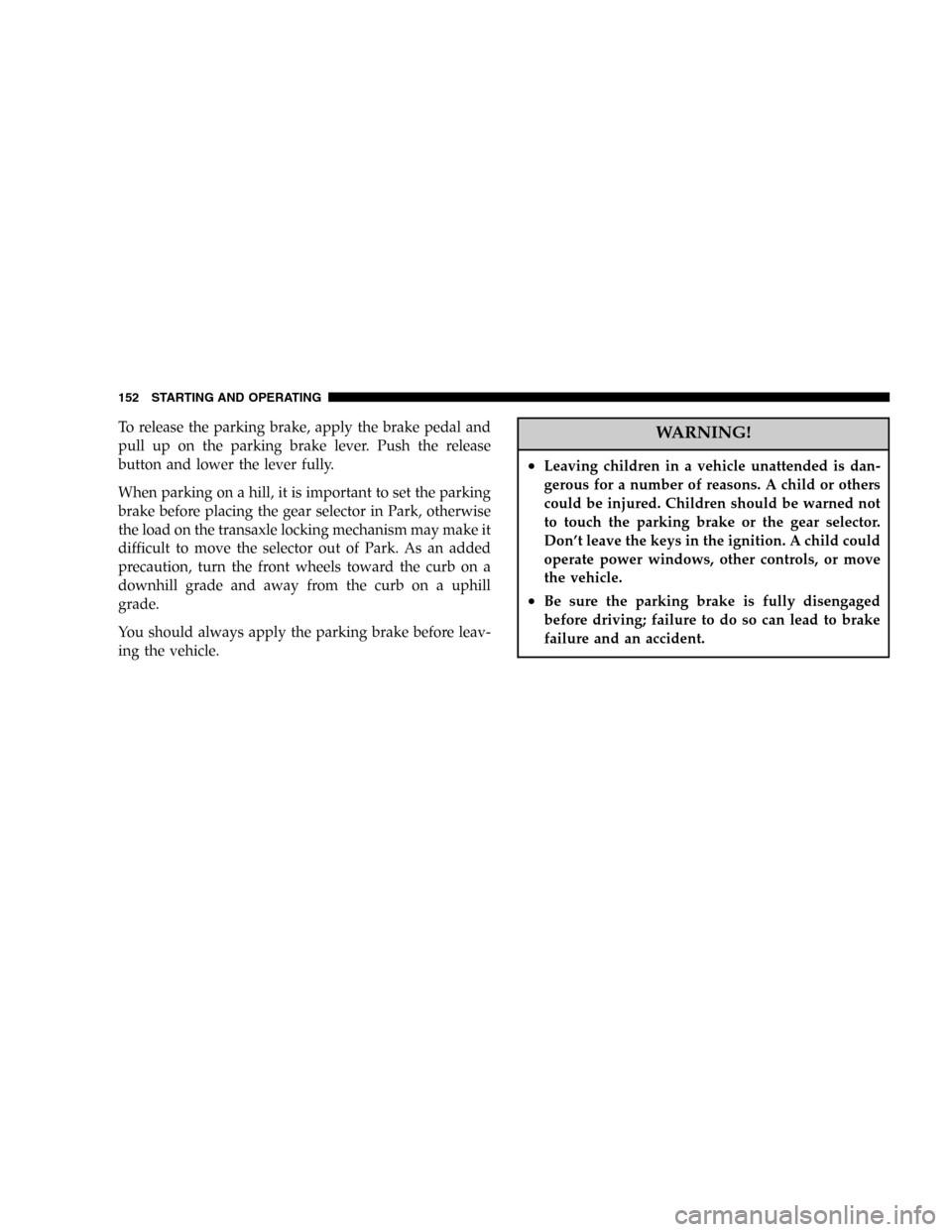2005 CHRYSLER SEBRING SEDAN parking brake
[x] Cancel search: parking brakePage 152 of 291

To release the parking brake, apply the brake pedal and
pull up on the parking brake lever. Push the release
button and lower the lever fully.
When parking on a hill, it is important to set the parking
brake before placing the gear selector in Park, otherwise
the load on the transaxle locking mechanism may make it
difficult to move the selector out of Park. As an added
precaution, turn the front wheels toward the curb on a
downhill grade and away from the curb on a uphill
grade.
You should always apply the parking brake before leav-
ing the vehicle.WARNING!
•Leaving children in a vehicle unattended is dan-
gerous for a number of reasons. A child or others
could be injured. Children should be warned not
to touch the parking brake or the gear selector.
Don’t leave the keys in the ignition. A child could
operate power windows, other controls, or move
the vehicle.
•Be sure the parking brake is fully disengaged
before driving; failure to do so can lead to brake
failure and an accident.
152 STARTING AND OPERATING
Page 188 of 291

Preparations for Jacking
Park the vehicle on a firm level surface, avoid ice or
slippery areas, and set the parking brake. Place the gear
selector in PARK.
•Turn on the Hazard Warning Flasher, park vehicle on
firm, level surface.
•Put gear shift in park (automatic transmission) or
reverse (manual transmission).
•Set parking brake and turn off engine.
•Passengers should not remain in the vehicle while the
vehicle is being jacked.
Changing a Tire
The spare wheel, scissors jack, and lug wrench are
stowed under the spare tire cover in the rear cargo area.
Do not attempt to raise this vehicle using a bumper jack.
188 WHAT TO DO IN EMERGENCIES
Page 192 of 291

JUMP-STARTING PROCEDURES IF BATTERY IS
LOW
WARNING!
•Do not attempt to push or tow your vehicle to get
it started. Vehicles equipped with an automatic
transaxle cannot be started this way. Unburned
fuel could enter the catalytic converter and once
the engine has started, ignite and damage the
converter and vehicle. If the vehicle has a dis-
charged battery, booster cables may be used to
obtain a start from another vehicle. This type of
start can be dangerous if done improperly, so
follow this procedure carefully.
•Take care to avoid the radiator cooling fan when-
ever the hood is raised. It can start anytime the
ignition switch is on. You can be hurt by the fan.
NOTE:The battery is stored in a compartment behind
the left front fender and is accessible without removing
the tire and wheel. Remote battery terminals are located
in the engine compartment for jump starting.
1. Wear eye protection and remove any metal jewelry
such as watch bands or bracelets that might make an
inadvertent electrical contact.
2. When boosting from a battery in another vehicle, park
that vehicle within booster cable reach but without
letting the vehicles touch. Set parking brake, place auto-
matic transaxle in PARK and turn ignition to OFF for
both vehicles.
3. Turn off the heater, radio and all unnecessary electrical
loads.
4. Connect one end of a jumper cable to the positive
terminal of the booster battery. Connect the other end to
the positive jump start attachment of the discharged
battery.
192 WHAT TO DO IN EMERGENCIES
Page 217 of 291

If you use a lubricant that cannot be dispensed directly
into the lock cylinder, apply a small amount of the
lubricant to the key. Insert the key into the lock cylinder,
then proceed as described above, to distribute the lubri-
cant within the lock cylinder. Pay attention to trunk
hinges, especially during cold weather, to ensure ease of
trunk operation.
Other Body Mechanisms
The following body mechanisms should be inspected
and, if necessary, all pivot and sliding contact areas of
these components should be lubricated with the lubricant
specified as follows:
Engine Oil
•
Door hinges
•Hood hinges
•Trunk hinges
Smooth White Body Lubricant - Such as Mopar
Spray White Lube:
•
Hood hinge springs and links
•Lock cylinders
•Parking brake mechanism
•Trunk latches
•Ash tray
Windshield Wiper Blades
Clean the rubber edges of the wiper blades and the
windshield periodically with a sponge or soft cloth and a
mild non abrasive cleaner. This will remove accumula-
tions of salt or road film.
Operation of the wipers on dry glass for long periods
may cause deterioration of the wiper blades. Always use
washer fluid when using the wipers to remove salt or dirt
from a dry windshield. Avoid using the wiper blades to
remove frost or ice from the windshield. Keep the blade
rubber out of contact with petroleum products such as
engine oil, gasoline, etc.
MAINTAINING YOUR VEHICLE 217
7
Page 228 of 291

Procedure For Checking Fluid Level
The fluid level in the automatic transaxle should be
checked whenever the vehicle is serviced. Operation with
an improper fluid level will greatly reduce the life of the
transaxle and of the fluid.
To properly check the automatic transaxle fluid level, the
following procedure must be used:
•The vehicle must be on level ground.
•The engine should be running at curb idle speed for a
minimum of 60 seconds.
•Fully apply parking brake.
•Place the gear selector momentarily in each gear
position ending with the lever in P (PARK).
•Wipe the dipstick clean and reinsert until seated.
Remove dipstick and note reading.
•If the fluid is cold (80°F/27°C), the reading should be
in the cross hatched area marked“COLD”(between
the lower two holes in the dipstick).
•If the fluid is hot (180°F/82°C), the reading should be
in the cross hatched area marked”HOT”(between the
upper two holes in the dipstick).
•If the fluid level shows low, add sufficient transmis-
sion fluid to bring to the proper level.
CAUTION!
Do not overfill. Dirt and water in the transaxle can
cause serious damage. To prevent dirt and water
from entering the transaxle after checking or replen-
ishing fluid, make certain that the dipstick cap is
seated properly.
Fluid and Filter Changes
Automatic transmission fluid and filter should be
changed as follows:
Maintenance schedule“A”—No change necessary.
Maintenance schedule“B”—Every 60,000 miles (96 000
km) change fluid and filter under the following condi-
tions:
228 MAINTAINING YOUR VEHICLE
Page 279 of 291

Special Additives..................... 229
Autostick............................. 173
Auxiliary Power Outlet................... 81
Ball Joints............................ 216
Battery............................... 212
Emergency Starting.................... 192
Gas Caution......................194,213
Heater............................. 146
Jump Starting........................ 192
Keyless Transmitter Replacement.......... 22
Location.........................192,213
Belts, Drive........................... 210
Belts, Engine.......................... 212
Body Mechanism Lubrication.............. 216
B-Pillar Location....................... 160
Brake, Parking......................... 151
Brake System.......................153,224
Anti-Lock........................... 153
Fluid Check......................... 226
Hoses.............................. 225
Master Cylinder...................... 226
Warning Light........................ 94Brake/Transmission Interlock...........147,149
Break-In Recommendations, New Vehicle...... 48
Bulb Replacement...................237,239
Bulbs, Light........................... 237
Capacities, Antifreeze (Engine Coolant)...... 243
Capacities, Fluid....................... 243
Caps, Filler
Fuel............................... 178
Oil (Engine)......................... 209
Radiator (Coolant Pressure).............. 222
Car Washes........................... 230
Carbon Monoxide Warning............... 177
Carpeting............................. 231
Cassette Tape and Player Maintenance....... 124
Cassette Tape Player...............101,109,112
Catalytic Converter..................... 211
CD Changer..................108,113,118,120
CD Player....................106,114,116,124
Center High Mounted Stop Light........... 241
Central Locking......................... 17
Chains, Tire........................... 171
Changing A Flat Tire.................... 187
INDEX 279
10
Page 287 of 291

Overdrive............................ 150
Overheating, Engine..................... 186
Owner’s Manual......................4,272
Paint Care............................ 229
Paint Damage......................... 229
Panic Alarm........................... 21
Parking Brake......................... 151
Parking On Hill........................ 152
Partial Zero Emissions Vehicle for 2.4 Liter.... 246
Passing Light........................... 68
Pets.................................. 47
Placard, Tire and Loading Information....... 160
Power
Brakes............................. 153
Door Locks.......................... 16
Outlet.............................. 81
Seats............................... 60
Steering............................ 155
Steering, Checking.................... 215
Sunroof............................. 79
Windows............................ 25
Power Steering Fluid.................... 244Pregnant Women and Seat Belts............. 33
Preparation for Jacking................... 188
Pretensioners
Seat Belts............................ 31
Programmable Electronic Features.........75,78
Programming Transmitters............21,75,78
Radial Ply Tires........................ 167
Radiator Cap (Coolant Pressure Cap)........ 222
Radio Broadcast Signals.................. 100
Radio Operation...............109,114,123,126
Radio Remote Controls.................. 122
Radio (Sound Systems).............101,109,114
Rear Seat, Folding....................... 62
Rear Window Defroster.................. 136
Rearview Mirrors........................ 56
Recommended Fluids, Lubricants and Genuine
Parts............................... 244
Reformulated Gasoline................... 175
Refrigerant............................ 215
Reminder, Lights On..................... 67
Reminder, Seat Belt...................... 32
Remote Keyless Entry.................... 19
INDEX 287
10